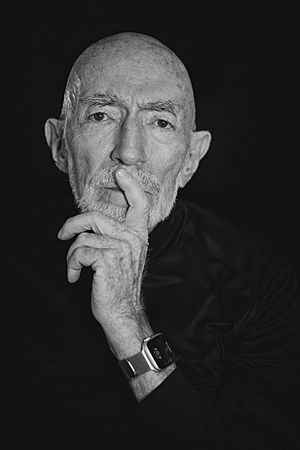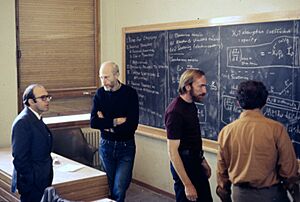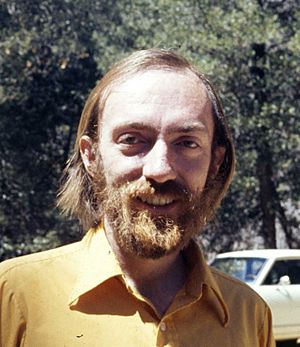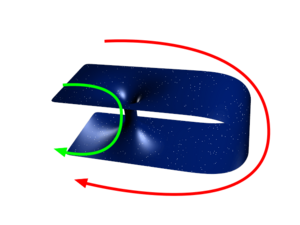Kip Thorne facts for kids
Quick facts for kids
Kip Thorne
|
|
|---|---|

Thorne in 2022
|
|
| Born |
Kip Stephen Thorne
June 1, 1940 Logan, Utah, U.S.
|
| Education | California Institute of Technology (BS) Princeton University (MS, PhD) |
| Known for | Gravitation (1973) Gravitational-wave astronomy Hartle–Thorne metric Hoop conjecture Interstellar (2014) LIGO Membrane paradigm Roman arch Thorne–Hawking–Preskill bet Thorne-Żytkow object |
| Spouse(s) |
Linda Jean Peterson
(m. 1960; div. 1977)Carolee Joyce Winstein
(m. 1984) |
| Children | 2 |
| Awards | Lilienfeld Prize (1996) Albert Einstein Medal (2009) Special Breakthrough Prize in Fundamental Physics (2016) Gruber Prize in Cosmology (2016) Shaw Prize (2016) Kavli Prize (2016) Harvey Prize (2016) Princess of Asturias Award (2017) Nobel Prize in Physics (2017) Lewis Thomas Prize (2018) |
| Scientific career | |
| Fields | Astrophysics Gravitational physics |
| Institutions | California Institute of Technology Cornell University |
| Thesis | Geometrodynamics of cylindrical systems (1965) |
| Doctoral advisor | John Archibald Wheeler |
| Doctoral students | William L. Burke Carlton M. Caves Lee Samuel Finn Sándor J. Kovács David L. Lee Alan Lightman Don N. Page William H. Press Richard H. Price Bernard F. Schutz Sherry Suyu Saul Teukolsky Michele Vallisneri Clifford Martin Will |
Kip Stephen Thorne, born on June 1, 1940, is an American theoretical physicist and writer. He is famous for his work in gravitational physics and astrophysics. In 2017, he won the Nobel Prize in Physics with Rainer Weiss and Barry C. Barish. They were honored for their important contributions to the LIGO detector and for observing gravitational waves.
Thorne is a longtime friend and colleague of famous scientists like Stephen Hawking and Carl Sagan. He was a professor at the California Institute of Technology (Caltech) until 2009. He often talks about how Einstein's theory of relativity affects space and stars. He still does scientific research and advises on projects, including the movie Interstellar.
Contents
Life and Career Highlights

Kip Thorne was born in Logan, Utah, on June 1, 1940. His parents were both professors. His father taught soil chemistry, and his mother was an economist. Growing up in a family of academics, two of his four siblings also became professors. Thorne has his own views on science and religion, stating that he believes there is no conflict between them.
Thorne showed great talent in academics from a young age. He won recognition in the Regeneron Science Talent Search while in high school. He earned his physics degree from Caltech in 1962. He then received his master's and PhD in physics from Princeton University in 1964 and 1965. His PhD advisor was John Archibald Wheeler.
He returned to Caltech as a professor in 1967. By age 30, he became one of the youngest full professors in Caltech's history. In June 2009, he retired from his main professorship. This allowed him to focus more on writing and working on movies.
Thorne has been a mentor to many leading physicists. About 50 physicists earned their PhDs at Caltech under his guidance. He is known for explaining complex ideas in physics to both scientists and the public. He has appeared on TV shows to discuss topics like black holes, gravitational radiation, relativity, and wormholes.
In 2023, Thorne co-authored a book called The Warped Side of Our Universe. This book uses poetry and illustrations to explain scientific ideas. He also worked with Lynda Obst and Stephen Hawking on a movie script.
Exploring the Universe Through Research
Thorne's research mainly focuses on relativistic astrophysics and gravitation physics. He studies relativistic stars, black holes, and especially gravitational waves. He is well-known for his ideas about wormholes and whether they could be used for time travel. His scientific work covers many topics about the nature of space, time, and gravity.
Gravitational Waves and LIGO
Thorne's work has helped predict the strength and patterns of gravitational waves. These patterns are very important for LIGO (Laser Interferometer Gravitational-Wave Observatory). LIGO is a huge experiment designed to detect these waves. In 1984, Thorne helped start the LIGO Project. It is the largest project ever funded by the NSF. Its goal is to find tiny ripples in space-time caused by massive cosmic events.
A big part of his research involves creating the mathematics needed to study these waves. Thorne also helps with the engineering design for LIGO. He advises on data analysis methods to find the waves. He has provided theoretical support for LIGO. This includes finding sources of gravitational waves that LIGO should look for. He also helped design parts of the detector to reduce unwanted light.
On February 11, 2016, scientists from the LIGO Scientific Collaboration announced a major discovery. In September 2015, LIGO detected the signal of two black holes colliding. This event happened 1.3 billion light-years away. This was the first direct observation of a gravitational wave. It confirmed a key prediction of Einstein's theory of general relativity.
Understanding Black Holes
While studying for his PhD, Thorne's mentor, John Archibald Wheeler, gave him a challenge. He asked Thorne to figure out if a cylindrical bundle of magnetic field lines would collapse under its own gravity. Thorne proved that it was impossible for cylindrical magnetic field lines to implode.
This led Thorne to explore why spherical stars collapse but cylindrical magnetic fields do not. He realized that gravity can overcome all internal pressure only when an object is squeezed in all directions. To explain this, Thorne proposed his hoop conjecture. This idea describes how a collapsing star turns into a black hole. It happens when a special "hoop" of a certain size can be placed around it.
Thorne and his students also developed a method called the "membrane paradigm". This approach helps understand black holes. They used it to explain how black holes might power quasars and active galactic nuclei.
Thorne has also studied the entropy of black holes. With his colleague Wojciech Zurek, he showed that a black hole's entropy relates to the number of ways it could have formed.
With Igor Novikov and Don Page, Thorne developed a theory about thin accretion disks around black holes. He found that if a black hole doubles its mass by gathering material, it will spin up to 99.8% of the fastest spin allowed by general relativity. This is likely the fastest a black hole can spin in nature.
Wormholes and Time Travel Ideas
Thorne and his team at Caltech researched whether the laws of physics allow for "traversable wormholes" and "time machines." With Sung-Won Kim, Thorne found a physical process that might prevent closed timelike curves (which would allow backward time travel) from forming.
With Mike Morris and Ulvi Yurtsever, he showed that traversable wormholes could exist. But they would need special quantum fields that have "negative energy." This idea has led to more research into how quantum fields might have such negative energy. Thorne's recent calculations suggest that simple objects passing through wormholes would not create paradoxes. This means that many time travel stories might actually have consistent solutions.
Other Important Discoveries
With Anna Żytkow, Thorne predicted the existence of red supergiant stars with neutron-star cores. These are called Thorne–Żytkow objects. He also helped create the theory for how relativistic stars pulsate and emit gravitational radiation. With James Hartle, Thorne developed rules for how black holes and other relativistic objects move and spin.
Thorne has also theorized about "exotic matter" that would have anti-gravity properties. This type of matter could help explain the universe's accelerating expansion. It might also keep traversable wormholes open or make "warp drives" possible. With Clifford Will and his students, Thorne helped create the framework for testing relativistic theories of gravity. As of 2005, Thorne was interested in how classical space and time might come from the "quantum foam" of quantum gravity theory.
Awards and Honors
Kip Thorne has received many honors and awards for his groundbreaking work. He has been elected to several prestigious academies, including the:
- American Academy of Arts and Sciences (1972)
- National Academy of Sciences
- Russian Academy of Sciences
- American Philosophical Society
Some of his notable awards include:
- American Institute of Physics Science Writing Award in Physics and Astronomy
- Phi Beta Kappa Science Writing Award
- American Physical Society's Lilienfeld Prize
- German Astronomical Society's Karl Schwarzschild Medal (1996)
- Albert Einstein Medal (2009)
- UNESCO Niels Bohr Medal (2010)
- Special Breakthrough Prize in Fundamental Physics (2016)
- Gruber Prize in Cosmology (2016)
- Shaw Prize (2016)
- Kavli Prize in Astrophysics (2016)
- Tomalla Prize (2016)
- Harvey Prize (2016)
- Smithsonian Magazine American Ingenuity Award for Physical Sciences (2016)
- Princess of Asturias Award (2017)
- Nobel Prize in Physics (2017)
- Lewis Thomas Prize (2018)
- Golden Plate Award of the American Academy of Achievement (2019)
He has also received honorary degrees from several universities. In 2016, Time magazine included Kip Thorne in its annual list of the 100 most influential people in the American world.
See also
 In Spanish: Kip Thorne para niños
In Spanish: Kip Thorne para niños




